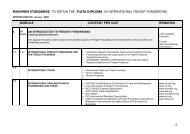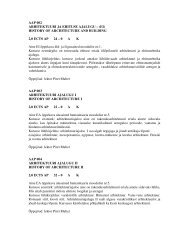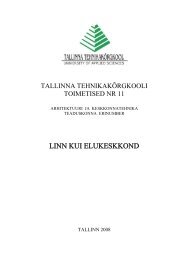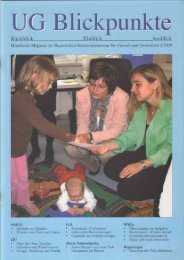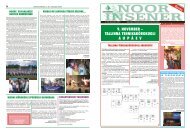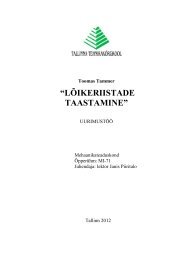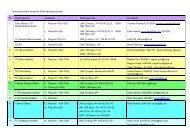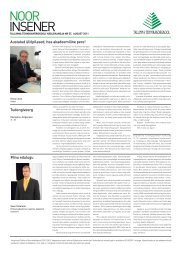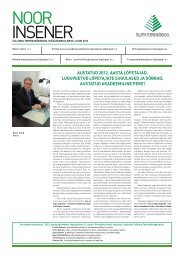norwegian upper secondary school students' views of mathematics ...
norwegian upper secondary school students' views of mathematics ...
norwegian upper secondary school students' views of mathematics ...
You also want an ePaper? Increase the reach of your titles
YUMPU automatically turns print PDFs into web optimized ePapers that Google loves.
NORWEGIAN UPPER SECONDARY SCHOOL STUDENTS’<br />
VIEWS OF MATHEMATICS AND IMAGES OF<br />
MATHEMATICIANS<br />
Barbro Grevholm<br />
University <strong>of</strong> Agder<br />
Norwegian <strong>upper</strong> <strong>secondary</strong> pupils’ <strong>views</strong> <strong>of</strong> <strong>mathematics</strong> and drawn images <strong>of</strong><br />
mathematicians are explored in this paper. Earlier research on the image <strong>of</strong><br />
<strong>mathematics</strong> is used as a theoretical foundation for the analysis <strong>of</strong> pupils’ answers.<br />
The view <strong>of</strong> <strong>mathematics</strong> is mostly linked to numbers and calculations although there<br />
are more sophisticated <strong>views</strong>. The images <strong>of</strong> mathematicians show an old, lonely<br />
man, <strong>of</strong>ten a bit strange-looking and rather passive. It seems as if such a pr<strong>of</strong>ession<br />
cannot be attractive for young students.<br />
INTRODUCTION<br />
It is <strong>of</strong>ten claimed that <strong>mathematics</strong> is hidden in the modern society and<br />
mathematicians are a very silent group <strong>of</strong> pr<strong>of</strong>essionals. As part <strong>of</strong> collaboration<br />
between <strong>school</strong> and university I was invited to an <strong>upper</strong> <strong>secondary</strong> <strong>school</strong> to meet<br />
students and talk about <strong>mathematics</strong>. The theme <strong>of</strong> the visit was “Meet an Agder-<br />
researcher”. I was supposed to present myself and my work to them as a<br />
mathematician and <strong>mathematics</strong> educator. In that situation it was interesting for me to<br />
know what conceptions they already had <strong>of</strong> a mathematician. In a try to be systematic<br />
I took the opportunity to ask the pupils to reply to two tasks before I started my<br />
presentation. The two tasks were to write down your own thoughts on “What is<br />
<strong>mathematics</strong>?” and to draw a picture <strong>of</strong> a typical mathematician. They willingly did<br />
so (and afterwards via the teacher I got their acceptance to use the products in a<br />
paper). Their work gave me an opportunity to investigate what pupils in a normal<br />
class in Norway see as <strong>mathematics</strong> and how they imagine a typical mathematician.<br />
The pupils were specialising in design and media and this might have influenced their<br />
ability to express themselves in drawing in a positive way. The <strong>school</strong> was a normal<br />
<strong>upper</strong> <strong>secondary</strong> <strong>school</strong> in one <strong>of</strong> the larger cities in Norway and the class consisted<br />
<strong>of</strong> 12 pupils.<br />
1- 1
RELATED LITERATURE AND THEORETICAL FRAMEWORK<br />
For an overview <strong>of</strong> research about “the <strong>mathematics</strong> image problem” I refer to Picker<br />
and Berry (2000). They sketch the development in research since the Draw-A-<br />
Scientist-Test initiated by Mead and Métraux (1957). Other researchers have<br />
approached the view <strong>of</strong> <strong>mathematics</strong> in different ways.<br />
Pehkonen and Törner (2004) introduced a three component model for belief systems<br />
with a tool box aspect, a system aspect and a process aspect. A fourth component was<br />
added later as the role <strong>of</strong> applications within <strong>mathematics</strong> (Grigutsch, Raatz &<br />
Törner, 1998). These researchers built on work <strong>of</strong> Dionne (1984), who pointed to the<br />
three perspectives: traditional, formalist and constructivist. They represent<br />
<strong>mathematics</strong> seen as a set <strong>of</strong> skills, as logic and rigor or as a constructive process,<br />
respectively.<br />
Roberta Mura (1993) has investigated images <strong>of</strong> <strong>mathematics</strong> held by university<br />
teachers <strong>of</strong> mathematical sciences. The question “How would you define<br />
<strong>mathematics</strong>?” was posed in a questionnaire to 173 university teachers. The analysis<br />
led to identification <strong>of</strong> the following themes: 1) The study <strong>of</strong> formal axiomatic<br />
systems, <strong>of</strong> abstract structure and object, <strong>of</strong> their properties, and relationships; 2)<br />
Logic, rigour, accuracy, reasoning, especially deductive reasoning, the application <strong>of</strong><br />
laws and rules; 3) a language, a set <strong>of</strong> notations and symbols; 4) design and analysis<br />
<strong>of</strong> models abstracted from reality, their application; 5) reduction <strong>of</strong> complexity to<br />
simplicity; 6) problem-solving; 7) the study <strong>of</strong> patters; 8) an art, a creative activity, a<br />
product <strong>of</strong> imagination, harmony and beauty; 9) a science, the mother, the queen, the<br />
core, a tool <strong>of</strong> other sciences; 10) truth; 11) reference to specific mathematical topics<br />
(number, quantity, shape, space, algebra etc). Mura concludes that the fact that some<br />
<strong>views</strong>, like formalism, are widespread among university teachers may explain and<br />
justify their prevalence among <strong>school</strong> teachers. Additionally changing <strong>school</strong><br />
teachers <strong>views</strong> may be an ambitious project for it may involve contradicting ideas<br />
they have received during their training. Or it may involve changing university<br />
teachers’ <strong>views</strong> as well (ibid, p 384).<br />
A more recent way to present what characterises a mathematician is given in the<br />
competence model by Niss (2004). Eight competencies are seen to be the constituents<br />
in mathematical competence: the competency <strong>of</strong> 1) mathematical thinking, 2)<br />
problem handling, 3) modelling, 4) reasoning, 5) representation, 6) symbols and<br />
formalism, 7) communication and 8) tools and aids.<br />
Picker and Berry (2000) have investigated pupils’ images <strong>of</strong> mathematicians. Pupils<br />
aged 12-13 years from United States, United Kingdom, Sweden, Romania and<br />
Finland were asked to draw a picture <strong>of</strong> a working mathematician. Their examination<br />
for commonalities in the 476 pictures identified these sub themes: Mathematics as<br />
coercion, the foolish mathematician, the overwrought mathematician, the<br />
mathematician who cannot teach, the Einstein effect, and the mathematician with
special powers. Picker and Berry propose a cycle <strong>of</strong> the perpetuation <strong>of</strong> stereotypical<br />
images <strong>of</strong> mathematicians and <strong>mathematics</strong> (see figure 1).<br />
Figure 1 The proposed Picker – Berry cycle <strong>of</strong> the perpetuation <strong>of</strong> stereotypical<br />
images <strong>of</strong> mathematicians and <strong>mathematics</strong> (Picker & Berry, 2000, p 86)<br />
Among implications for pedagogy and conclusions Picker and Berry (2000) mention<br />
that teachers appear to be largely unaware <strong>of</strong> pupils’ lack <strong>of</strong> knowledge about<br />
mathematicians and the role teachers can play in shaping and changing pupils’ <strong>views</strong><br />
about them (p 89). “Teachers need to learn with greater clarity what it is that<br />
mathematicians do and there is no reason why they cannot do this alongside with<br />
their pupils.” (ibid, p 90) Picker and Berry see the tool they have developed as an<br />
effective beginning for ascertaining pupils’ beliefs about <strong>mathematics</strong> and<br />
mathematicians. It can be a means to challenge negative <strong>views</strong> and stereotypes.<br />
Maria Bjerneby Häll (2002, 2006) followed a group <strong>of</strong> student teachers during their<br />
teacher education and the first three years after their debut as <strong>mathematics</strong> teachers in<br />
<strong>school</strong>. One aim <strong>of</strong> her study was to describe and analyse arguments for <strong>mathematics</strong><br />
in compulsory <strong>school</strong>. During the education the student teachers develop a view on<br />
<strong>mathematics</strong> and <strong>mathematics</strong> education that is in harmony with the goals <strong>of</strong><br />
<strong>mathematics</strong> in the national syllabus. The main arguments that were presented by the<br />
student teachers were to manage with ones everyday life, for future education and<br />
occupation, to take care <strong>of</strong> ones own interests in society, because society needs and<br />
demands this knowledge, to develop thinking skills, because it is funny and will<br />
increase ones self-confidence, it is needed in many other <strong>school</strong>-subjects, it is an<br />
important body <strong>of</strong> knowledge and a language, it is part <strong>of</strong> our culture and common<br />
knowledge, and because there will be a test.
The images here are analysed by picture analysis (Långström & Viklund, 2010)<br />
asking how persons and things are grouped/placed in the image, what age and gender<br />
they have, and how they are dressed and moving. Further I describe the background,<br />
foreground, the middle, left and right in the picture, if any. Validation was done by<br />
comparing with the descriptions made by a colleague.<br />
The students in this study have an age between those in the Picker and Berry study<br />
and in the studies <strong>of</strong> student teachers and teachers. I will make use <strong>of</strong> theoretical<br />
elements from several <strong>of</strong> the above mentioned studies in the analysis below.<br />
VIEWS OF MATHEMATICS<br />
The pupils’ written answers to the question “Hva er matematikk?” (What is<br />
<strong>mathematics</strong>?) will be presented here before the analysis. The exact wording in<br />
Norwegian is given first and then my translation in parenthesis afterwards. I have<br />
numbered the replies 1-12 in order to be able to link the respective drawings to the<br />
descriptions <strong>of</strong> <strong>mathematics</strong>.<br />
1 Regning med tall (Calculations with numbers)<br />
2 Læren/kunnskapen om tall, utregninger… (The theory/knowledge about numbers,<br />
calculations…)<br />
3 Læren om tall og deres funsjon (The theory about numbers and their function)<br />
4 Jeg tror matematikk er læren om tall og deres funksjoner. Matematikk er også en måte<br />
på å bruke hjernen til å utløse problemer. (I think <strong>mathematics</strong> is the theory about tall and<br />
their functions. Mathematics is also a way to use the brain to solve problems).<br />
5 Tall, formler, likninger, naturvitenskap. (Numbers, formulas, equations, natural<br />
science).<br />
6 En ting du bruker hver dag, en måte å finne ut ting på med tall. (Something you use<br />
every day, a way to find out about things with numbers).<br />
7 Matematikk er et verktøy for å løse små og store problemer. Med hjelp av matematikk<br />
kan vi lage forenklede modeller av virkeligheten og forutsi et svar på et problem.<br />
(Mathematics is a tool for solving small and large problems. With the help <strong>of</strong><br />
<strong>mathematics</strong> we can create simpified models <strong>of</strong> reality and hypothesise an answer to a<br />
problem).<br />
8 Matematikk er tall og regning. (Mathematics is numbers and calculations).<br />
9 Mattematikk er tall satt i systemer med system som kan multiplisere, dividere osv.<br />
Matte er i alt. Alt er matte. Stolene er matte, (Mathematics is numbers into systems with<br />
systems which can multiply, divide and so on. Maths is in everything. Everthing is<br />
maths. The chairs are maths,<br />
10 Matematikk forbinder jeg med tall og størrelser og forholdet mellom dem. Kanskje<br />
bruker vi matematikken til å kartlegge våre omgivelser. (I relate <strong>mathematics</strong> to numbers
and quantities and the relation between them. Maybe we use <strong>mathematics</strong> to map our<br />
surroundings).<br />
11 Tall eller symboler som legges sammen i en sum. (Numbers or symbols put together<br />
into a sum).<br />
12 Ulike ”verdier” og samspillet mellom dem. (Different “values” and the interplay<br />
between them).<br />
IMAGES OF MATHEMATICIANS<br />
The twelve images I got from the pupils are enclosed in the appendix. I will now try<br />
to describe them as fully as possible before I analyse them. The copies <strong>of</strong> the original<br />
images are in the appendix.<br />
Drawing number one has a text above it: ”The typical mathematician:”. The picture<br />
shows a nice looking man in suite with his hands folded together in front <strong>of</strong> him. The<br />
age is indefinite; he could be young or old. The face looks calm and kind and both<br />
eyes and mouth are large and visible. The mouth seems to have a small smile on it.<br />
The hair is curly and large but not un-normally large. He looks like a normal man but<br />
maybe a little bit shy?<br />
Drawing number two shows an older man with round spectacles and a pen behind his<br />
left ear. He seems to be dressed in some kind <strong>of</strong> laboratory coat. He holds a pointer in<br />
his right hand and rests it on the floor. The left hand is in his pocket. In his <strong>upper</strong><br />
pocket we can see a pencil and a ruler sticking up. His trousers are a little bit too<br />
long. He is almost bald and has a skewed smile on his face.<br />
Drawing number three has one part <strong>of</strong> an egg-shaped head on two foots which is<br />
crossed over. The other part is a man in trousers and naked <strong>upper</strong> body. His hair is<br />
large and curly, the mouth shows the teeth, the eyes are just two empty circles and<br />
there seems to be a small moustache. He is walking with his arms hanging straight<br />
down.<br />
Drawing number four shows a head <strong>of</strong> a man on an <strong>upper</strong> body which is just<br />
indicated. He is partly bald and has horn-rimmed spectacles. He has a little bit <strong>of</strong> dark<br />
hair on the sides <strong>of</strong> his head and he carries a black beard. The mouth is closed and<br />
expressionless. He is squint-eyed and speaks out a mathematical expression in a<br />
bubble. He looks a little bit frightening and cold.<br />
Drawing number five shows a walking man with a rather small body and a large head<br />
with a long neck and the Adam’s apple visible. He has a beard and the mouth is open<br />
and shows big teeth. The nose is big and the spectacles even bigger but the eyes are<br />
just two black dots. On the top <strong>of</strong> his head there are two straws <strong>of</strong> hair standing up.<br />
He looks frightening somehow.<br />
Drawing number six has an explaining text, which says: “I see an old man with a lot<br />
<strong>of</strong> hair on his head and spectacles sitting at a desk doing calculations on many
pages.” My interpretation is that the man is leaning deeply over the pages on the desk<br />
and writing intensely. The bodily expression <strong>of</strong> the man is friendly.<br />
Drawing number seven shows a man sitting at a desk, scratching his long thin black<br />
hair so that the scurf is whirling around. On the desk there is a cup <strong>of</strong> steaming c<strong>of</strong>fee<br />
and a beaker with many stumps <strong>of</strong> cigarettes, some still giving smoke. The face is<br />
strange with two eyes on each side <strong>of</strong> what could be a very long nose and a big mouth<br />
dividing the face in two parts. The <strong>upper</strong> teeth are shown in a long straight row and<br />
there is growing beard on the cheek. The image has the label ‘The mathematician’.<br />
Drawing number eight shows a man sitting at a desk in a room with a bookshelf full<br />
<strong>of</strong> books, a blackboard full <strong>of</strong> notes (12+4+x+a 3 =~ ….) and paper basket full <strong>of</strong><br />
crumpled papers. On top <strong>of</strong> the desk there is a book in front <strong>of</strong> the man, a ruler, a<br />
computer (?) and a paper. The man is thinking √25 + mc 2 , which is shown in a<br />
bubble. The man has curly hair and spectacles and a little smile on his face. There is<br />
peacefulness in the room.<br />
Drawing number nine is a head <strong>of</strong> a man, drawn in red ink. It is a triangle shaped<br />
head with big unordered hair and a long tapering beard. The mouth is dark and<br />
hidden in the beard, the nose is strong and the eyes are narrow. The face is somewhat<br />
expressionless.<br />
Drawing number ten shows a man sitting in a dark room at a desk with a strong lamp<br />
enlightening his working area. He works on a computer. On the floor there is a<br />
striped home-woven carpet and two pictures on the wall. One picture shows sun, the<br />
other the number 4 (could indicate a calendar?). We see the man from the back so the<br />
face is not accessible.<br />
Drawing number eleven shows a man walking and above his head is written 3 times<br />
√9 raised to 12 π s. He has short black hair and an expressionless face. The hands are<br />
drawn in a childish way with just five lines as fingers.<br />
Drawing number twelve is the <strong>upper</strong> half <strong>of</strong> a man with spectacles and dark hair close<br />
to his head. The eyes are wide open and somehow starring. The nose is small. In his<br />
pocket is a pencil. Beside him is a cascade <strong>of</strong> mathematical expressions springing out<br />
<strong>of</strong> a hole (2+3=5, √4 divided by 2 2 times x b 3 =z, E= mc 2 ). He has a lot <strong>of</strong> dots in his<br />
face and maybe a cigarette in his mouth?<br />
ANALYSIS<br />
In the answers to what is <strong>mathematics</strong> the most common word is numbers (mentioned<br />
10 times) and second common is calculations and to solve problems (mentioned 3<br />
times each). Although the answers are rather short taken together they represent<br />
several <strong>of</strong> the categories found by Mura. Mathematics is seen as a formal system,<br />
models and application, symbols, a tool, and there are references to arithmetic and<br />
relations. Mentioned are the mathematical objects number, problem, equation, model,
quantity, formula, relation, symbol and operations such as calculate, solve, sum,<br />
multiply, divide and model. The three aspects from Pehkonen and Törner (2004) are<br />
present: toolbox, system and process. Even applications in the form <strong>of</strong> models <strong>of</strong><br />
reality and prognoses are mentioned. The answers seem to be neutral or positive in<br />
attitude (something you use every day, it is everywhere) compared to the negative<br />
aspects given by younger students in the Picker and Berry study. On the other hand it<br />
is rather simple descriptions <strong>of</strong> <strong>mathematics</strong> compared to the answers from the more<br />
mature student teachers or teachers in the studies by Bjerneby Häll and Mura.<br />
What can we learn from the drawn images <strong>of</strong> mathematicians? They are all men and<br />
most <strong>of</strong> them are old. They are all alone. In three cases (6, 8 and 10) a kind <strong>of</strong><br />
working environment is indicated. The workplace is a desk in an <strong>of</strong>fice. The working<br />
tools we see are paper, pen, pencil, ruler, pointer, computer, books, numbers and<br />
mathematical symbols. Six <strong>of</strong> them are wearing spectacles. Three <strong>of</strong> them are<br />
walking, four <strong>of</strong> them sitting at a desk and the rest just standing still. Three <strong>of</strong> them<br />
have a beard. In four cases we see mathematical expressions linked to the men. These<br />
expressions seem to be used to indicate the activity <strong>of</strong> mathematical thinking.<br />
There are a number <strong>of</strong> stereotypes given in the images. The mathematician is a man,<br />
not a woman. He is old, he is lonely, has <strong>of</strong>ten spectacles and sometimes beard. The<br />
content <strong>of</strong> the mathematician’s work is hidden. We only get to know that he is<br />
working at a desk, he is thinking on numbers and symbols, writing or computing. But<br />
what is he actually doing? Only one person could be teaching, the man with the<br />
pointer. One has a blackboard in his room which could indicate teaching or at least<br />
talking to someone else about the work. Compared to the eight competencies<br />
mathematicians need to have (Niss, 2004) we can trace little <strong>of</strong> them in the images.<br />
The drawings in this study are from pupils about five years older than the ones in the<br />
study by Picker and Berry (2000). This seems to be an important difference as we do<br />
not find the violence or intimidation <strong>of</strong> pupils seen there. The mathematician as a<br />
teacher is much less common and the foolish person is also missing. The common<br />
features are the nerd, the strange-looking person and the lonely person. In the images<br />
<strong>of</strong> the younger pupils there are pupils present in the pictures, which is not the case<br />
among the <strong>upper</strong> <strong>secondary</strong> pupils’ drawings. The latter might not see their<br />
<strong>mathematics</strong> teacher as a mathematician?<br />
Is becoming a mathematician an exciting future for a young student in <strong>school</strong>? Can<br />
they see the inspiring, aesthetic, challenging aspects <strong>of</strong> <strong>mathematics</strong> mentioned in<br />
Mura’s study? It is hard to see how the students could identify with the images they<br />
have drawn. Where is the excitement <strong>of</strong> solving mathematical problems, where is the<br />
excitement <strong>of</strong> working together with other people, <strong>of</strong> teaching young students, <strong>of</strong><br />
modelling diverse situations in society and assisting with solutions to important<br />
problems for the future? Such aspects <strong>of</strong> the work <strong>of</strong> a mathematician are obviously<br />
hidden to these students. They see the mathematician as someone very different from<br />
themselves.
CONCLUSIONS<br />
Data in this paper consists <strong>of</strong> descriptions and drawings from only 12 pupils in <strong>upper</strong><br />
<strong>secondary</strong> <strong>school</strong>, thus no general conclusions should be made based on it. But it<br />
raises a number <strong>of</strong> questions that might be further explored. Why are the pupils<br />
holding these <strong>views</strong> <strong>of</strong> <strong>mathematics</strong> and images <strong>of</strong> mathematicians? Would we like<br />
pupils to have other <strong>views</strong> and images? How did the pupils build up these <strong>views</strong> and<br />
images? Is it possible to break the “evil” cycle modelled by Picker and Berry? Do<br />
<strong>mathematics</strong> teachers ever discuss with their pupils about what <strong>mathematics</strong> actually<br />
is and what a mathematician is doing? Are the competencies <strong>of</strong> mathematicians<br />
(Niss, 2004) ever visible for students? We know little about answers to these<br />
questions. Lately some films and TV-series have been produced with mathematicians<br />
acting. Such examples could <strong>of</strong> course help inform pupils about the work <strong>of</strong><br />
mathematicians. We do not know if pupils see those films or if they get any<br />
impression at all from them. And it is very rare that working mathematicians want to<br />
take time to contribute to the public picture <strong>of</strong> <strong>mathematics</strong> and mathematicians.<br />
For young persons today it is probably crucial to get another image <strong>of</strong> <strong>mathematics</strong><br />
before they even consider studying <strong>mathematics</strong> or becoming a mathematician or<br />
scientist. Society and the educational system have a huge task here in making<br />
<strong>mathematics</strong> more visible to pupils in <strong>school</strong>.<br />
References<br />
Bjerneby Häll, M. (2002). Varför undervisning i matematik? FiF-avhandling 60/02,<br />
Licentiatavhandling. Institutionen för beteendevetenskap, Linköpings universitet.<br />
Bjerneby Häll, M. (2006). Allt har förändrats och allt är sig likt. En longitudinell studie av<br />
argument för grundskolans matematikundervisning. Li U Linköping: Studies in<br />
Education and Psychology, no 110.<br />
Dionne, J. (1984). The perception <strong>of</strong> <strong>mathematics</strong> among elementary <strong>school</strong> teachers. In J.<br />
Moser (Ed.), Proceedings <strong>of</strong> the 6 th annual meeting <strong>of</strong> the North American Chapter <strong>of</strong> the<br />
international group for the psychology <strong>of</strong> <strong>mathematics</strong> education (PME) (pp.223-228).<br />
Madison, WI: University <strong>of</strong> Wisconsin.<br />
Grigutsch, S., Raatz, U. & Törner, G. (1998). Einstellungen gegenuber Mathematik bei<br />
Mathematiklehrern. Journal fur Mathematik-Didaktik 19 (1), 59-66.<br />
Långström, S. & Viklund, U. (2010). Metoder – undervisning och framträdande. Lund<br />
Studentlitteratur.<br />
Mead, M. & Métraux, R. (1957). Image <strong>of</strong> the scientist among high-<strong>school</strong> pupils. Science<br />
126(3269), 384-390.<br />
Mura, R. (1993). Images <strong>of</strong> <strong>mathematics</strong> held by university teachers <strong>of</strong> mathematical<br />
sciences. Educational Studies <strong>of</strong> Mathematics, 25, 375-385.<br />
Niss, M. (2004). The Danish “KOM”-project and possible consequences for teacher<br />
education. In R. Stræsser, G. Brandell, B. Grevholm, O. Helenius (Eds.), Educating for
the Future. Proceedings <strong>of</strong> an International Symposium on Mathematics Teacher<br />
Education. (pp.179-190). Stockholm: The Royal Swedish Academy <strong>of</strong> Sciences.<br />
Pehkonen, E. & Törner, G. (2004). Methodological considerations on investigating<br />
teachers’ beliefs <strong>of</strong> <strong>mathematics</strong> and its teaching. Nordic Studies in Mathematics<br />
Education Vol 9 No 1, 21-49.<br />
Picker, S., & Berry, J. S. (2000). Investigating pupils’ images <strong>of</strong> mathematicians.<br />
Educational Studies <strong>of</strong> Mathematics, 43, 65-94.



